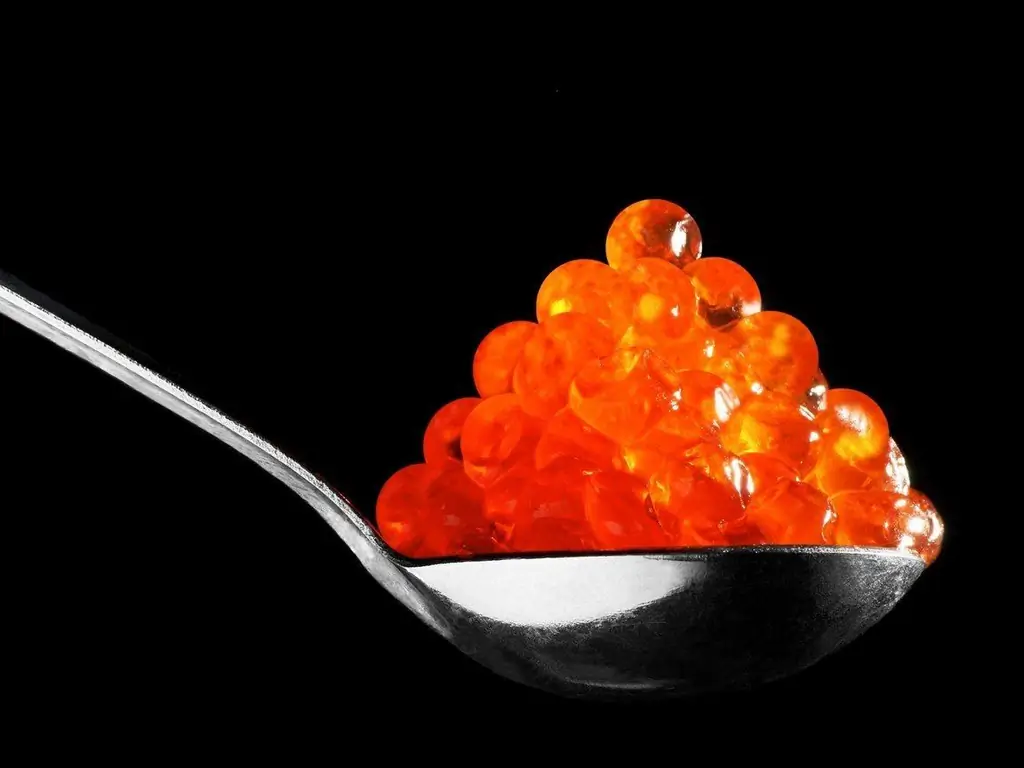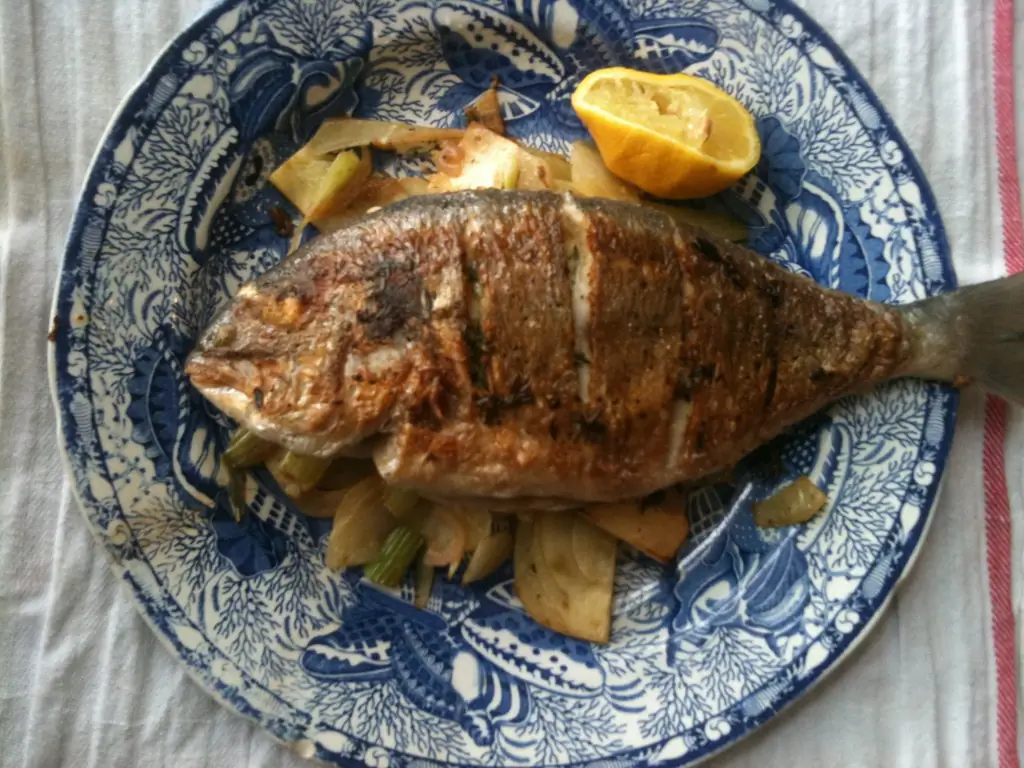
Table of contents:
- Author Bailey Albertson [email protected].
- Public 2023-12-17 12:53.
- Last modified 2025-06-01 07:32.
Rules for choosing red caviar in the store

Caviar is one of the most popular delicacies, and we try to serve it on the table for any occasion. Fortunately, there is no caviar deficit on store shelves now. But how to make the right choice, not make a mistake in the quality of the product and not spend a lot of money on a frankly bad product? Today we will talk about caviar and tell you what criteria should be used to choose it in the store.
Content
- 1 Is the container a quality guarantee?
- 2 Different fish - different caviar
-
3 We buy red caviar according to the rules
3.1 Tips on GOST
- 4 Tips from experienced forums
- 5 How to choose the right quality product (video)
Is the container a quality guarantee?
Now caviar is packaged in different types of packaging. As a rule, these are:
- glass jars;
- metal (tin) cans;
- plastic containers.
You can often find unpackaged, loose caviar.

For packing caviar, glass, metal and plastic containers are used.
Each type of packaging has its own advantages and disadvantages. Let's try to understand them.
-
In a glass jar, you can easily examine the product and understand whether fresh caviar is already losing quality. The disadvantages include the fact that transparent glass transmits light, which destroys the vitamins contained in the caviar. But this is solved by storing the product in a dark room without direct light access or by packing a glass jar in a cardboard box. The rest of the glass container is quite reliable for caviar.

can of caviar Red caviar in a glass jar
-
Caviar in a metal can is reliably hidden from prying eyes, and you will not be able to 100% determine the quality of the product until you open the package. But on the other hand, caviar is well stored in tin cans for a long time.

Tin can with caviar Red caviar in a tin can
-
More and more often, caviar is found on store shelves in hard plastic containers with sealed lids. The shelf life of the product in such packaging is short compared to glass or metal. But if you follow the storage rules, the plastic container is quite safe. The main thing is that the plastic container is not soft and contains the necessary identification marks. In addition, through the transparent surface, you can appreciate the appearance of the content.

red caviar in plastic Red caviar in plastic packaging
- It's not so simple with caviar by weight. On the one hand, it has an undeniable advantage: you can try it before buying and understand whether it contains enough salt, whether there is any foreign taste or smell, how loose it is. But on the other hand, it may be caviar that has been frozen or unsuitable for packaging due to the expiration date, overripe. This can negatively affect the quality of the product.
When buying, give preference to caviar in a glass jar packed in a cardboard box.
Different fish - different caviar
Do not forget that the caviar of a particular fish may differ significantly. This applies to shape, color, taste. Only the content of proteins, fats and microelements remains practically the same.
Following the further descriptions of the characteristics, you can easily learn to determine by eye what you are dealing with.

In different fish species, caviar can vary significantly in appearance.
- Among salmon fish, pink salmon is considered the most prolific. Its caviar has a universal taste that almost all consumers enjoy. The diameter of the eggs is about 5 mm, the shell is not very dense, the color is orange or light orange.
- Chum salmon caviar is in second place in terms of size: the diameter of the eggs is 5-6 mm. They have a regular spherical shape, a bright amber-orange color, a well-visible fatty spot of the embryo. Chum caviar is often used as a decoration for dishes because of its spectacular appearance. Due to the rather dense shell, the caviar of this fish is not to everyone's taste.
- Chinook salmon have the largest eggs, 6-7 mm in diameter, deep red with a bitter-spicy taste. True, today chinook salmon caviar can no longer be found on store shelves, since this fish is listed in the Red Book.
- Coho salmon have small caviar with a burgundy tint. The eggs taste a little bitter.
- Trout has the smallest eggs - 2-3 mm in diameter. Caviar color - from yellow to bright orange.
- Sockeye caviar is slightly smaller than pink salmon - up to 4 mm in diameter. Recently, it has rarely been found on the free market due to the massive extermination of this type of fish.
In addition, flying fish roe is often found. She came to us along with the fashion for Japanese cuisine. But no matter what the sellers tell you, this product does not belong to the category of red caviar in our usual sense. Flying fish eggs are initially colorless; sauces and seasonings make them red. In the same way, this caviar can be made green, blue or black.
We buy red caviar according to the rules
- Caviar should be bought only at trusted retail outlets. Be sure to ask for a product certificate if you have any suspicions.
- If you buy caviar in a glass or tin can, shake the package. High-quality caviar fills the container tightly without forming voids; it will not dangle and flow from one side to the other. Also, gurgling should not be heard, as this is a sure sign of a poor-quality product that "let the juice" or was improperly processed and packaged.
- The poor quality of caviar is evidenced by a too weak or very dense shell of eggs.
- When buying caviar by weight, pay attention to how crumbly the grains are. In a fresh and high-quality product, the eggs should easily separate from each other and not stick to the scapula.
- Red caviar is a very delicate product that requires special storage conditions. According to GOST, caviar in an unpacked container can be stored for up to 12 months, observing a temperature regime of 4-6 degrees Celsius. It is strictly forbidden to store in the freezer: the eggs burst from frost, and when thawed, they turn into a homogeneous mass. After the can of caviar has been opened, it must be consumed within a few days.
- When opening the jar, keep in mind: there should be no eggs adhered to the lid.
- If you buy caviar in a metal can, pay attention to the labeling. All numbers indicating the date of packaging and shelf life must be squeezed out from the inside. Numbers pressed inward are a sure sign of a fake. In addition, the edges of the can should be straight and the seams invisible.
- Check how tightly the jar is rolled up (both glass and metal). The lid should not be even slightly swollen. The opposite indicates that an unacceptable microflora lives and develops in the bank.
-
In addition to the date of manufacture and expiration date, bona fide manufacturers indicate on the label or packaging the type of fish from which the caviar was obtained, the number of the manufacturer and the shift, the "ICRA" assortment mark, the "P" index of the fishing industry and the content of other products. Usually it is salt and vegetable oil. Sometimes preservatives are added, which significantly extend the shelf life. Experts say that in small doses, these preservatives are not harmful, but allergy sufferers are advised to be careful with such ingredients.

Rules for choosing red caviar Rules for choosing red caviar
GOST Tips
Read the label carefully to understand the composition of the product. According to GOST, a can of caviar should contain only the following components:
- salt;
- vegetable oil;
- E400 - glycerin to prevent drying out of caviar;
- E200 and E239 are antiseptics that are not used separately from each other.
The presence of other additives in caviar is contrary to GOST, and you run the risk of purchasing a low-quality product that is harmful to health
In order to determine if the caviar is good, you can also weigh the jar on an electronic scale. The standard weight is about 180 grams. The underweight of 15-25 grams significantly reduces the cost of production, which is often used by unscrupulous manufacturers.
Experienced tips from forums
How to choose the right quality product (video)
Now you know how to choose the right caviar in the store. Your holiday will not be spoiled by an unpleasant surprise, and delicious pancakes, vases, tartlets and sandwiches with this delicacy will appear on the table. Bon Appetit!
Recommended:
How To Choose Heating Radiators - Types Of Radiators And How To Choose Them Correctly

How to choose heating radiators? Varieties and comparative analysis of heating radiators on the Russian market
Lychees In The Store: When They Appear, Including In Auchan, How To Choose Them Correctly

When the lychee season begins. Is it possible to buy lychee all year round. What determines their appearance in the store. How to choose delicious lychees
Gable Trim, Including Which Material To Choose, As Well As How To Carry Out The Work Correctly

The structure, types and purpose of the pediment. Why do we need a pediment facing? Materials used for cladding. Necessary tools and stages of work
How To Fry Bream In A Pan Deliciously And Correctly, Including Its Caviar, Video

Step by step recipes for cooking fried bream. Required ingredients, different ways to fry bream and its caviar
Original Appetizers With Red Caviar

What snacks with red caviar can be prepared to surprise guests
